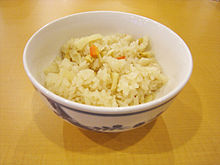Takikomi gohan

Takikomi gohan (炊き込みご飯, 炊き込み御飯) is a Japanese rice dish seasoned with dashi and soy sauce along with mushrooms, vegetables, meat, or fish. The ingredients of takikomi gohan are cooked with the rice; in a similar preparation, maze gohan (混ぜ御飯), flavorful ingredients are mixed into cooked rice.[1] This dish is consumed by people in Japan around the fall season since many root vegetables and mushrooms are harvested during this season in Japan.[2] Ingredients will vary based on the seasonal vegetables and fish. Since this dish contains nutritional value, and uses a small amount of rice with vegetables and proteins, some Japanese people eat it for dieting purposes.[3] One of the reasons why this dish is popular in Japan is because it is easy to make and does not require a lot of equipment to prepare.
History
Takikomi gohan was created during the Nara period.[4] During this period, rice was scarce so they mixed rice with millet to increase the amount of portions. It is called awameshi. Around the same time, people created an early form of takikomi gohan called katemeshi. They mixed rice with millet or other grains, wild vegetables, yam or Japanese radish to conserve rice.[4] During the Muromachi period, katemeshi became popular, turned into a dish called kawarimeshi using ingredients such as barley, beans, and vegetables. Over time people became creative and made a variety of dishes with seasonal ingredients.[4]
Difference from maze gohan
The usual process to make takikomi gohan is to add all the ingredients such as rice, broth, soy sauce, vegetables and a protein source into a rice maker at once, on the other hand, maze gohan mixes ingredients such as vegetables and a protein source with cooked rice.[5]
Variations
- Tai-meshi (鯛飯): rice with whole sea bream[6]
- Ayu-meshi (鮎飯): rice with whole sweetfish
- Matsutake gohan (松茸御飯): rice with matsutake mushrooms
- Kani-meshi (蟹飯): rice with crab
- Gomoku meshi (五目飯 or gomoku gohan 五目御飯): loosely translated, "five ingredients mixed rice," whose contents often revolve around seasonal availability and can include matsutake or shiitake mushrooms, bamboo shoots, burdock root, fresh soybeans, chestnuts, chicken, firm white-fleshed fish, or oysters.[7] In the Osaka dialect, this dish is called kayaku gohan (加薬御飯).[8]
- Kamameshi (釜飯): all the ingredients are cooked in a single use kettle and serve as is[9]
- Kuri gohan (栗ご飯): rice with chestnuts[10]
- kufa jūshī (クファジューシー): an Okinawan cuisine of rice with pork[11]
See also
- Arroz con Pollo, Arroz con gandules, Platillo Moros y Cristianos, Gallo Pinto, Pabellón criollo, Rice and beans (Latin America)
- Biryani (South Asia)
- Fried Rice (East Asia)
- Jambalaya (Louisiana)
- Jollof rice (West Africa)
- Hoppin' John (Southern United States)
- Kabsa (Saudi Arabia)
- Kedgeree (United Kingdom)
- Kushari (Egypt)
- Nasi Goreng (Indonesia)
- Paella (Spain)
- Pilaf/Pulao (Greece, Balkans, Turkey, Iran, Central Asia, South Asia)
- Rice and peas (Caribbean)
- Risotto (Italy)
- Spanish rice (Mexico)
Notes
- ^ Tsuji, Shizuo. Japanese Cooking: A Simple Art. Kodansha International. 2006, p. 276.
- ^ 9月に美味しい旬の野菜. (n.d.). Retrieved November 05, 2020, from https://foodslink.jp/syokuzaihyakka/syun/monthly/septembre-ve.htm
- ^ Watanabe, A. (2020, October 05). 炊き込みご飯のカロリー・糖質は?白米よりダイエット向きな理由は?. Retrieved November 05, 2020, from https://chisou-media.jp/posts/598
- ^ a b c "takikomi gohan" たきこみごはん. 米穀安定供給確保支援機構 (Rice Stable Supply Support Organization) (Japan) (in Japanese). Archived from the original on 2004-12-31. Retrieved 2022-11-03.
- ^ 基本の五目炊き込みご飯のレシピ/作り方:白ごはん.com. (n.d.). Retrieved October 30, 2020, from https://www.sirogohan.com/recipe/kayakugohan/
- ^ Tsuji, Shizuo. Japanese Cooking: A Simple Art. Kodansha International. 2006, p. 277.
- ^ Tsuji, Shizuo. Japanese Cooking: A Simple Art. Kodansha International. 2006, p. 278.
- ^ Tsuji, Shizuo. Japanese Cooking: A Simple Art. Kodansha International. 2006, p. 278.
- ^ Kamameshi, Tororomeshi. (n.d.). Retrieved October 30, 2020, from https://www.asahibeer.co.jp/area/04/shitamachi/vol01.html
- ^ Yukimasa, Rika (2016-11-25). "Rika's TOKYO CUISINE Chestnut Rice – Kuri gohan 栗ご飯". NHK. Archived from the original on 2017-04-30. Retrieved 2022-11-04.
- ^ "Our Regional Cuisines: kufa jushi, Okinawa Prefecture" うちの郷土料理 クファジューシー 沖縄県. Ministry of Agriculture, Forestry and Fisheries (Japan) (in Japanese). Archived from the original on 2022-04-07. Retrieved 2022-11-04.
References
- Hosking, Richard. A Dictionary of Japanese Food: Ingredients & Culture. Tuttle Publishing, 1997, p. 46
- Tsuji, Shizuo. Japanese Cooking: A Simple Art. Kodansha International. 2006, p. 278.
